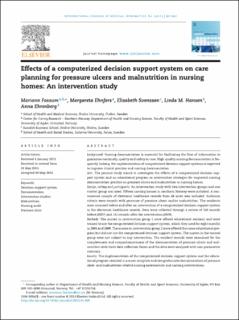| dc.contributor.author | Fossum, M. | |
| dc.contributor.author | Ehnfors, M. | |
| dc.contributor.author | Svensson, E. | |
| dc.contributor.author | Hansen, L. M. | |
| dc.contributor.author | Ehrenberg, A. | |
| dc.date.accessioned | 2021-05-28T15:53:57Z | |
| dc.date.available | 2021-05-28T15:53:57Z | |
| dc.date.issued | 2013 | |
| dc.identifier.citation | Fossum, M., Ehnfors, M., Svensson, E., Hansen, L. M. & Ehrenberg, A. (2013). Effects of a computerized decision support system on care planning for pressure ulcers and malnutrition in nursing homes: An intervention study. The International Journal of Medical Informatics, 82(10), 911–21. | en_US |
| dc.identifier.uri | https://hdl.handle.net/11250/2756933 | |
| dc.description.abstract | Background
Nursing documentation is essential for facilitating the flow of information to guarantee continuity, quality and safety in care. High-quality nursing documentation is frequently lacking; the implementation of computerized decision support systems is expected to improve clinical practice and nursing documentation.
Aim
The present study aimed at investigate the effects of a computerized decision support system and an educational program as intervention strategies for improved nursing documentation practice on pressure ulcers and malnutrition in nursing homes.
Design, setting and participants
An intervention study with two intervention groups and one control group was used. Fifteen nursing homes in southern Norway were included. A convenience sample of electronic healthcare records from 46 units was included. Inclusion criteria were records with presence of pressure ulcers and/or malnutrition. The residents were assessed before and after an intervention of a computerized decision support system in the electronic healthcare records. Data were collected through a review of 150 records before (2007) and 141 records after the intervention (2009).
Methods
The nurses in intervention group 1 were offered educational sessions and were trained to use the computerized decision support system, which they used for eight months in 2008 and 2009. The nurses in intervention group 2 were offered the same educational program but did not use the computerized decision support system. The nurses in the control group were not subject to any intervention. The resident records were examined for the completeness and comprehensiveness of the documentation of pressure ulcers and malnutrition with three data collection forms and the data were analyzed with non-parametric statistics.
Results
The implementation of the computerized decision support system and the educational program resulted in a more complete and comprehensive documentation of pressure ulcer- and malnutrition-related nursing assessments and nursing interventions.
Conclusion
This study provides evidence that the computerized decision support system and an educational program as implementation strategies had a positive influence on nursing documentation practice. | en_US |
| dc.publisher | The International Journal of Medical Informatics | en_US |
| dc.subject | decision support system | en_US |
| dc.subject | documentation | en_US |
| dc.subject | intervention studies | en_US |
| dc.subject | malnutrition | en_US |
| dc.subject | nursing audit | en_US |
| dc.subject | pressure ulcer | en_US |
| dc.subject | trykksår | en_US |
| dc.subject | pasientsikkerhet | en_US |
| dc.title | Effects of a computerized decision support system on care planning for pressure ulcers and malnutrition in nursing homes: An intervention study | en_US |
| dc.type | Journal article | en_US |
| dc.source.pagenumber | 911–21 | en_US |
| dc.source.volume | 82 | en_US |
| dc.source.journal | The International Journal of Medical Informatics | en_US |
| dc.source.issue | 10 | en_US |
| dc.identifier.doi | https://doi.org/10.1016/j.ijmedinf.2013.05.009 | |
| dc.description.localcode | måsjekkes | |
